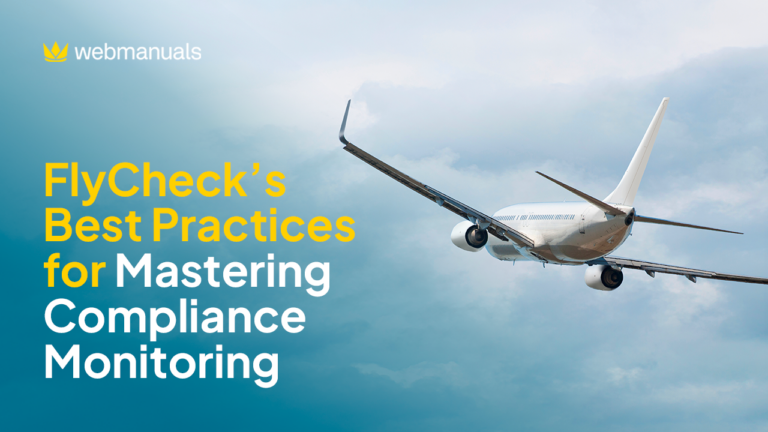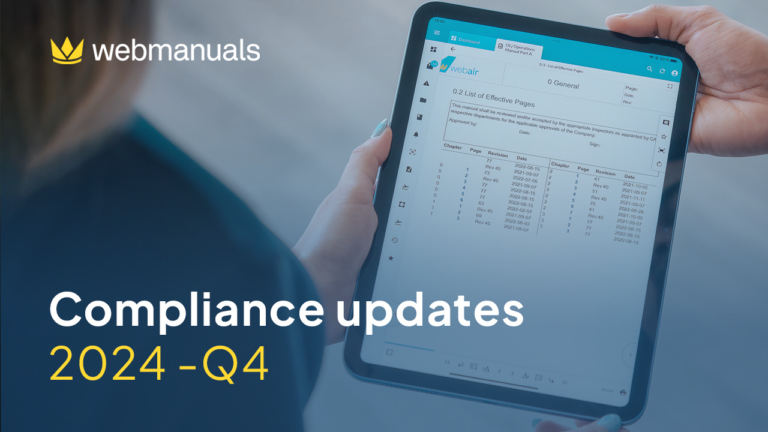Icelandair, a prominent player in the aviation sector, recently faced the intricate task of merging with Flugfélag Íslands (Air Iceland). The complexities were not limited to operational adjustments but extended to the meticulous documentation processes vital for ensuring safety and compliance.
During Go Digital EMEA 2023, Icelandair stole the spotlight for its effective ability to transform and improve its documentation even during the merger with Air Iceland. Not only did they win the Change Maker Award, but Sharon Kerr, Quality & Improvement Specialist, and Krystal Pettigrew, Content Compliance Specialist, captivated the audience with a valuable presentation. This dynamic duo provided a thorough presentation on the challenges Icelandair confronted during the merger and shed light on how the implementation of the Web Manuals system played a pivotal role in their triumphant journey.

As part of the restructuring project, they have become Document Control Admins, where they support all the different departments within the company, provide training and support, do final checks, set up all the admin, and the rules, as well as liaise with Safety and Compliance.
Synergizing Operations: Pursuing Company-Wide Standardization
The merger brought together two distinct airlines, each with its own Air Operator Certificate (AOC) and associated Continuing Airworthiness Management Organizations (CAMOs). With over 50 destinations on their roster, spanning domestic and international routes, the scale of the merger was vast.
Icelandair, IOSA certified since 2006, operates 44 aircraft, including various Boeing models for international flights, and Bombardier 200 and 400 aircraft flying domestically and to Greenland.
Operating with two separate documentation sites for Icelandair and Flugfélag Íslands, the merger’s urgency amplified as it coincided with the impending IOSA audit. Icelandair felt the urge to merge all manuals onto one site, especially as Flugfélag aimed for its initial certification in November 2023. The project initially planned for a six-month duration, was completed in an impressive eight weeks with the support of Web Manuals.
Using their experience, we present here five tips to keep in mind when facing a major restructuring of your documentation:
1. Refresh your memory for the system you use
It’s easy to overlook initial setups in a long-used system. As organizations evolve, it’s crucial to adapt and better utilize tools like Web Manuals. Regular updates and staying informed within the system are key to efficient operations.
When you’re in the system for a long time it’s really easy to forget the initial setups for designs because you set this up once in the system, and then you don’t really have to worry about it.
Sharon explained that each company had established the documentation system exactly how they wanted it to be and how it worked for each company. But when the project began, together with Krystal they had to re-think the set-up to take advantage of the software at the fullest. “With all this restructuring, we were also taking a look at how we can better utilize Web Manuals to suit our needs as the companies change. And with this came a lot of working projects to see how we can manage this better”, says Sharon.
Furthermore, it’s really important to understand that as the providers’ companies grow and develop, you have to change with it. Keeping staff updated within the system can change and improve your way of working every day.
“We had great support from the Web Manuals team all the way. We arranged training sessions to refresh our memory in the system, and we managed to move all the documentation over the summer. We had great communication to make all this possible”, continues Sharon.
“Our whole team uses the system and they are happy with it. We have trainings regularly to keep the team updated, especially for those who don’t use the system as much as we do. The feedback from the Reader App is also very positive and it’s working really great”, explains Sharon.
2. Set up a structure that works first
Establishing a solid internal project working group that provides clear definitions of roles, precise labeling of documents and folders, and thoughtful structuring of workflows are essential for the success of the project.

To start the project, they had an internal project working group and they had to assign dedicated representatives for flight operations and tech operations. And, as an outcome of the project, now they have a centralized staff, which is Sharon and Krystal as Document Control Admins supporting all the departments at Icelandair.
This facilitated defining the foundation, or initial settings which helped to establish clear guidelines for a comprehensive structure that serves as the backbone of the documentation and compliance process.
a) Define roles first
The designation of roles and users is fundamental for any process. By using Web Manuals, they had the system support to clarify each role, assign those to the correct users, and provide access to exactly the documents they need access to. “There was quite a bit of prep work, but it definitely paid off, in the end, to stay organized”, explains Krystal.
b) Labeling of documents and folders must be clear
Setting naming guides for documents and folders helps everyone to work properly in the system and avoid confusion that can affect their daily work. Using clear prefixes for differentiating structures was a relevant learning outcome for the Icelandair team.
Because Icelandair is a bigger and more complex company the documentation structure and access is extensive and occasionally repetitive, making it overly complicated. Flugfélag due to its smaller size was easier to maintain a simple setup. Therefore, the goal was to mirror the folder system that Flugfélag had on their site to the new Icelandair site.
“We want to have the two things similar, and we put FXI and ICE in front of each folder and in front of each document name to be sure that it’s identifiable because when you have two OMMs or two OMBs, it’s really difficult to look through and see which is which. So you have to be sure that things are identified”, describes Sharon.
c) Establish workflows before importing your documents
Once everything was transferred over, then they started the review and had to go through the workflows and make sure that everything matched up.
As explained by Sharon, the workflows should be part of the initial steps because they shape authoring, reviewing, and control processes: “The workflows were interesting because Flugfélag had an extra step that Icelandair didn’t. So then we had to discuss how to adjust the workflows. Since it takes a lot of effort to adjust a workflow once the manuals are already in the system, I recommend getting it really sorted out first because changing a thousand documents isn’t so easy. The structure is so important.”
3. Transfer documents and link your regulations
Standardizing designs and logos, downloading PDFs initially for content mirroring verification, and carefully handling the transfer of unpublished documents are key steps. The importance of detailed preparation work and revising page structures and connections cannot be overstated.
As commented by Sharon, if you’re working with different AOCs or similar, you have to be aware that you need to create the design for that company, or when you transfer the first document it’s going to have the wrong logo.
“We transferred all the PDFs first. Then we transferred over the published documents and had the person responsible for the manual review and make sure that all the content mirroring was in properly. Then we had to check the design because sometimes the layouts or paragraphs were off. Only after that, the editor could start working on the manuals.”
“Then we got into moving unpublished documents, which was a little more nerve-wracking because people were in the middle of editing and they were all panicking about what was going to happen to all their information. But since it’s digital it’s all going to be there. Again, we had to make sure that all the diagrams and the content mirroring were in and we got those moved over. People had to verify once again that everything was correct, and then they could start editing.”
The regulatory linking for IOSA was facilitated by the Web Manuals system, as it allows the creation of controlled links between regulations and paragraphs, easing the compliance monitoring process.
“The structure of Technical manuals are determined by the regulations, and the Icelandic aviation authority provides an outline of exactly how they want our manual setup. Hence, the manual structure in Icelandair is almost identical to Flugfélag which made the linking of regulations easy because, we could copy what was already done by Icelandair. This made those IOSA linking a lot faster and easier and then someone just needed to go through and verify. Furthermore, you can have the link validation in your workflow, where you have compliance review as an actual step in the manual process.”, clarifies Sharon.
4. Set the reviewing and validating process
It’s key to establish who is in charge of updating the compliance linking and who will be responsible for keeping them updated from now on.
One really important thing is determining who’s responsible for the compliance libraries, and not just updating but verifying the links. For Icelandair, the Document Control Admins were in charge of initially linking all regulations, but the responsibility of validating and keeping them updated is on the manager or the document owner.
“The way we do it in Icelandair is our Quality department does a Management of Change Audit, and they will put regulations as nonconformity. The nonconformity is simply to drive the department to go through the manuals, do a gap analysis, and be very clear about which part of the manual needs to be updated to identify what is compliant and what is no longer compliant.”
“We send a non-compliance with the link to regulation, and then it’s our responsibility to go in and look at the EASA regulation, document everything, see what’s going to be fixed, and then link it.”, explains Sharon.
However, it’s very important to keep in mind the smaller changes as well. As explained in the presentation, when major regulatory changes happen, most likely all departments affected by it are aware of it. But when smaller updates happen, it’s more feasible to overlook the impact of those changes on other manuals.
“But that’s the benefit of the Web Manuals system, that it’s designed to flag you when you make a change that affects other manuals when using content mirroring for example. Since we always have the final review when manuals are published, we always check for warnings, and we can see if something comes up.”, explains Sharon.
5. Communicate within your team
The success of such projects lies in effective communication within the team. Maintaining open communication with Quality department and supporting daily operations is crucial.
Team effort is fundamental to making projects like this thrive. You need communication among the people involved to articulate as well as possible. Also, to get different perspectives on the same topic. People will be able to detect problems and see solutions that only one person working alone can miss.
As explained by Sharon and Krystal, this is particularly relevant when related to regulatory linking and compliance library updates: “I think it’s really important to have good communication with the departments you’re working with, so you’re not just wildly updating and people are falling behind the scenes there. The last thing people want is just blindly being slammed with library updates. We try to work well with Quality and talk when we’re going to update, to see if they need to do a management change audit or how it’s going to be handled.”
“Neither one of us could do it as well alone. We work really well together and our strengths complement each other. We have really good communication and it helps us work through the system better. I think it’s really important when you’re working in the system to find someone to work alongside, whether it be someone in the community or someone within your company because you’re stronger working as a team instead of working alone.”
What’s coming next for Icelandair?
The anticipation of more documents, compliance libraries, potential links, and additional work underscores the transformative nature of change, portrayed as an exciting journey rather than a daunting task.
Sharon and Krystal explained that Icelandair has recently signed the contract for Airbus aircraft which we be an addition to the existing fleet. They signed a contract for 25 A321XLRs that will start delivery in 2029. However, they’ve also signed a MOU for four A321LR aircraft starting fall 2024. Icelandair has a lot going on in the future.
“We have very exciting, exciting times ahead. A little bit of the unknown still, we don’t really know what it all entails yet. We just know we’re going to have more documents, more compliance libraries, potential links, and lots of work ahead but it’s a really exciting time. Change is fun.”, concludes Krystal.




